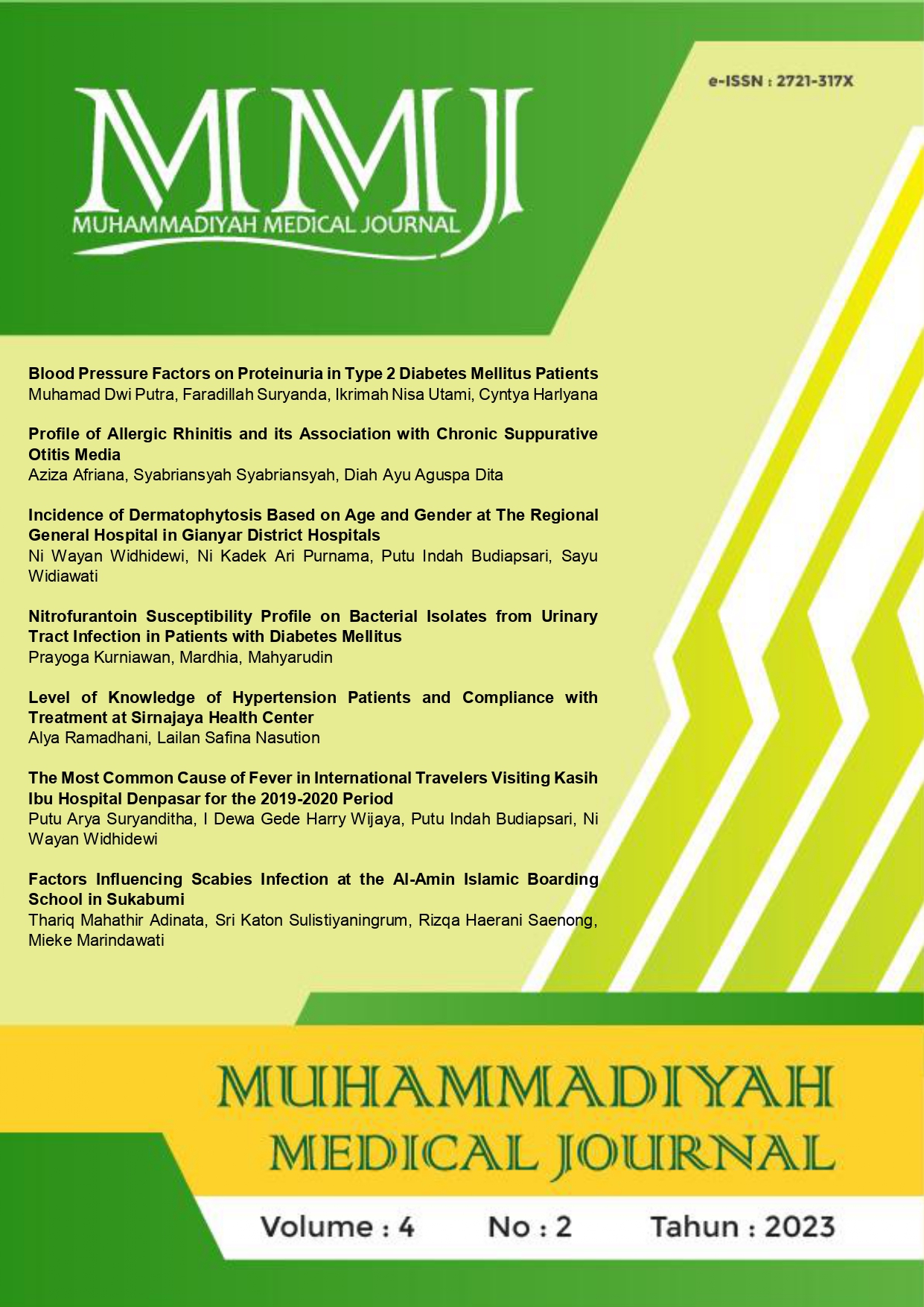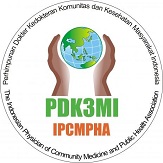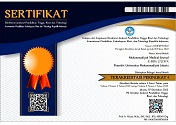Nitrofurantoin Susceptibility Profile on Bacterial Isolates from Urinary Tract Infection in Patients with Diabetes Mellitus
DOI:
https://doi.org/10.24853/mmj.4.2.79-85Keywords:
antibiotic susceptibility, diabetes mellitus, nitrofurantoin, urinary tract infectionAbstract
Background: Patients with diabetes mellitus have a higher risk of urinary tract infection (UTI) incidence than those without. One of the first-line therapy for UTI is nitrofurantoin. The emergence of drug-resistant UTIs is increasing both in community and healthcare setups. Purposes: Determine the nitrofurantoin susceptibility profile to bacteria causing UTI in diabetic patients. Method: A cross-sectional study was conducted at the Microscopic Laboratory, Faculty of Medicine, Universitas Tanjungpura, Pontianak, from February to November 2019. The antibiotic susceptibility testing was performed by the Kirby-Bauer disk diffusion method on 22 bacterial isolates. The samples were collected on a sterile urine pot, cultured on agar, and identified by biochemistry test, and bacterial isolates were stored at 2-8oC. The bacterial isolates were sub-cultured 24h before the susceptibility test. The susceptibility testing used a 300 µg nitrofurantoin disk. The diameter of zone inhibition was measured and classified based on Clinical and Laboratory Standard Institute guidelines. Result: The results showed that Escherichia coli was 41.67% susceptible (5/12), Shigella sp. was 100% intermediate (1/1), and Enterobacter aerogenes (3/3), Pseudomonas aeruginosa (1/1), Klebsiella sp (1/1) were 100% resistant. Conclusion: The majority of the causative bacteria for UTI in diabetic patients are resistant to nitrofurantoin, suggesting the use of nitrofurantoin should be reconsidered as an empirical antibiotic in Pontianak. Further study using a larger population should be conducted to describe a more extensive antibiotic susceptibility profile of diabetic patients with UTI in Pontianak.References
Kamei J, Yamamoto S. Complicated urinary tract infections with diabetes mellitus. J Infect Chemother Off J Japan Soc Chemother. 2021 Aug;27(8):1131–6.
Gupta K, Trautner BW. Urinary Tract Infections, Pyelonephritis, and Prostatitis. In: Jameson JL, Fauci AS, Kasper DL, Hauser SL, Longo DL, Loscalzo J, editors. Harrison’s Principles of Internal Medicine, 20e. New York, NY: McGraw-Hill Education; 2018.
Christy P, Sidjabat HE, Lumban Toruan AA, Moses EJ, Mohd Yussof N, Puspitasari Y, et al. Comparison of Laboratory Diagnosis of Urinary Tract Infections Based on Leukocyte and Bacterial Parameters Using Standardized Microscopic and Flow Cytometry Methods. Int J Nephrol. 2022;2022:9555121.
Departemen Kesehatan Republik Indonesia. Survei demografi dan kesehatan Indonesia 2014. Jakarta; 2014.
Storme O, Tirán Saucedo J, Garcia-Mora A, Dehesa-Dávila M, Naber KG. Risk factors and predisposing conditions for urinary tract infection. Ther Adv Urol. 2019;11:1756287218814382.
Salari N, Karami MM, Bokaee S, Chaleshgar M, Shohaimi S, Akbari H, et al. The prevalence of urinary tract infections in type 2 diabetic patients: a systematic review and meta-analysis. Eur J Med Res. 2022 Feb;27(1):20.
Prajapati AK. Urinary Tract Infection in Diabetics. In: Behzadi P, editor. Microbiology of Urinary Tract Infections - Microbial Agents and Predisposing Factors [Internet]. Rijeka: IntechOpen; 2018. p. Ch. 4. Available from: https://doi.org/10.5772/ intechopen.79575
Saraswati D, Martini M, Saraswati LD. Gambaran leukosituria tanda infeksi saluran kemih pada penderita diabetes mellitus tipe-2 (studi di wilayah kerja puskesmas Ngesrep). J Kesehat Masy. 2018 Jan 2;6(1):225–35.
Nur Z, Mardhia M, Mahyarudin. Gambaran Bakteri Penyebab Infeksi Saluran Kemih Pada Urin Penderita Diabetes Melitus Tipe 2. Maj Kedokt Andalas. 2022;45(2):173–84.
Mochtar CA, Noegroho BS. Infeksi saluran kemih (ISK) non komplikata pada dewasa. Guideline penatalaksanaan infeksi saluran kemih dan genitalia pria 2015. 2015. 22–34 p.
WHO Expert Committee on the Use of Essential Drugs. WHO Model Lists of Essential Medicines 21st ed [Internet]. Geneva; 2019. Available from: https://www.who.int/ groups/expert-committee-on-selection-and-use-of-essential-medicines/essential-medicines-lists
Nath T, Das SK, Hazra S. Pattern of uropathogens and antibiotic sensitivity in diabetes patients attending to out - Patient department and diabetes clinic of a teaching hospital: A cross-sectional study. J Fam Med Prim care. 2021 Oct;10(10):3638–43.
Naghavi M. Global burden of bacterial antimicrobial resistance in 2019: a systematic analysis. Lancet (London, England). 2022 Feb;399(10325):629–55.
Seputra KP, Tarmono, Noegroho BS, Mochtar CA, Wahyudi I, Renaldo J, et al. Panduan tata laksana infeksi saluran kemih dan genitalia pria. Malang: Ikatan Ahli Urologi Indonesia; 2020. 6–16 p.
Norafika, Arbianti N, Prihatiningsih S, Indriani DW, Indriati DW. A retrospective cross-sectional study of urinary tract infections and prevalence of antibiotic resistant pathogens in patients with diabetes mellitus from a public hospital in Surabaya, Indonesia. Germs. 2020 Sep;10(4):157–66.
CLSI. Performance Standards for Antimicrobial Susceptibility Testing. Wayne, PA: Clinical and Laboratory Standards Institute; 2019.
CLSI. Methods for dilution antimicrobial susceptibility tests for bacteria that grow aerobically; Approved Standard. Wayne: PA: Clinical and Laboratory Standards Institute; 2012. 52 p.
Ortez JH. Disk Diffusion Testing. In: Manual of antimicrobial susceptibility testing. American Society for Microbiology; 2005. p. 41.
Bono MJ, Leslie SW, Reygaert WC. Urinary Tract Infection. In: StatPearls Publishing. Treasure Island (FL): StatPearls; 2022.
Rachman NO, Muhammad DP, Lia YB. Uji Sensitivitas Bakteri Terhadap Saluran Kemih Pada Pasien Diabetes Melitus Terhadap Ceftriaxone,Levofloksasin dan Gentamisin. Berk Kedokt. 2015;12(2):205–13.
Amladi AU, Abirami B, Devi SM, Sudarsanam TD, Kandasamy S, Kekre N, et al. Susceptibility profile, resistance mechanisms & efficacy ratios of fosfomycin, nitrofurantoin & colistin for carbapenem-resistant Enterobacteriaceae causing urinary tract infections. Indian J Med Res. 2019 Feb;149(2):185–91.
Alemu A, Geta M, Taye S, Eshetie S, Engda T. Prevalence, associated risk factors and antimicrobial susceptibility patterns of Shigella infections among diarrheic pediatric population attending at Gondar town healthcare institutions, Northwest Ethiopia. Trop Dis Travel Med vaccines. 2019;5:7.
Oumer O, Metaferia Y, Gebretsadik D. Bacterial uropathogens, their associated factors, and antimicrobial susceptibility pattern among adult diabetic patients in two health centers at Kombolcha town, Northeastern Ethiopia. SAGE open Med. 2022;10:20503121221139148.
Badulla WFS, Alshakka M, Mohamed Ibrahim MI. Antimicrobial Resistance Profiles for Different Isolates in Aden, Yemen: A Cross-Sectional Study in a Resource-Poor Setting. Biomed Res Int. 2020;2020:1810290.
Anggraini D, Yulindra UG, Savira M, Djojosugito FA, Hidayat N. Prevalensi dan Pola Sensitivitas Antimikroba Multidrug Resistant Pseudomonas aeruginosa di RSUD Arifin Achmad. Maj Kedokt Bandung [Internet]. 2018;50:6–12. Available from: https://api.semanticscholar.org/CorpusID:79511919
Gautam G, Gogoi S, Saxena S, Kaur R, Dhakad MS. Nitrofurantoin Susceptibility Pattern in Gram-Negative Urinary Isolates: In Need of Increased Vigilance. J Lab Physicians. 2021 Sep;13(3):252–6.
Pang Z, Raudonis R, Glick BR, Lin T-J, Cheng Z. Antibiotic resistance in Pseudomonas aeruginosa: mechanisms and alternative therapeutic strategies. Biotechnol Adv. 2019;37(1):177–92.
Bălăşoiu M, Bălăşoiu AT, Mănescu R, Avramescu C, Ionete O. Pseudomonas aeruginosa resistance phenotypes and phenotypic highlighting methods. Curr Heal Sci J. 2014;40(2):85–92.
Gandee L, Hsieh J-T, Sperandio V, Moreira CG, Lai C-H, Zimmern PE. The efficacy of immediate versus delayed antibiotic administration on bacterial growth and biofilm production of selected strains of uropathogenic Escherichia coli and Pseudomonas aeruginosa. Int Brazilian J Urol Off J Brazilian Soc Urol. 2015;41:67–77.
Zaitseva J, Granik V, Belik A, Koksharova O, Khmel I. Effect of nitrofurans and NO generators on biofilm formation by Pseudomonas aeruginosa PAO1 and Burkholderia cenocepacia 370. Res Microbiol. 2009 Jun;160(5):353–7.
Downloads
Published
Issue
Section
License
Authors who publish in the Muhammadiyah Medical Journal agree to the following terms:
- Authors retain copyright and grant Muhammadiyah Medical Journal right of first publication with the work simultaneously licensed under a Creative Commons Attribution Licence that allows others to adapt (remix, transform, and build) upon the work non-commercially with an acknowledgement of the work's authorship and initial publication in Muhammadiyah Medical Journal.
- Authors are permitted to share (copy and redistribute) the journal's published version of the work non-commercially (e.g., post it to an institutional repository or publish it in a book), with an acknowledgement of its initial publication in Muhammadiyah Medical Journal.








